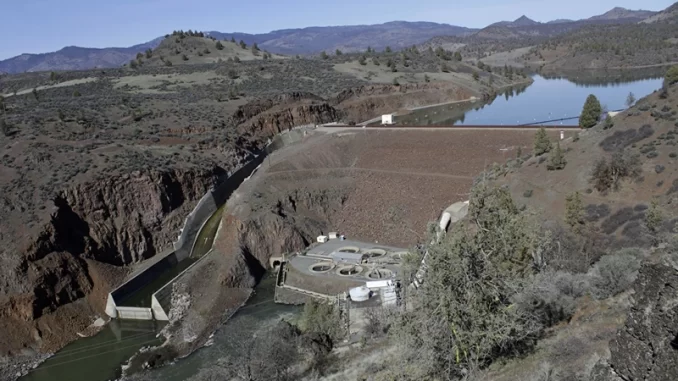

OAN’s Elizabeth Volberding
6:00 PM – Monday, January 15, 2024
This week, the lowering of dammed reservoirs on the Klamath River marked a significant milestone in the largest dam removal project in United States history.
Advertisement
On Thursday, the gate on the lowest of the bypass tunnels planned for removal, which is 16-feet-wide and located at the base of Iron Gate Dam in Northern California, was accessed from a crack to 36 inches.
In order for the bypass tunnel at the base of Northern California’s Iron Gate Dam to withstand the weight of flowing waters coming through it, it has undergone major reinforcement.
Member of the Yurok Tribe and attorney, Amy Cordalis, played a crucial role in advocating for the removal of the dam.
According to the organization’s website, the Yurok Tribe’s mission is to “exercise the aboriginal and sovereign rights of the Yurok People to continue forever our Tribal traditions of self-governance, cultural and spiritual preservation, stewardship of Yurok lands, waters and other natural endowments…”
“This is historic and life-changing,” Cordalis explained. “And it means that the Yurok people have a future. It means the river has a future; the salmon have a future.”
Mike Belchik, a senior policy adviser for the Yurok Tribe, was also in attendance to see the controlled breach. Belchik has worked on Klamath River water projects for the tribe for nearly 30 years.
“It’s kind of surreal,” said Belchik. “I don’t know why we had such confidence that it was going to happen. But we did. We always knew it would happen.”
The Iron Gate Dam is a 143-foot-tall earth embankment dam with a narrow reservoir behind it, which has a 740-foot crest. Three hydroelectric dams that are still a part of the Lower Klamath Project in southern Oregon and Northern California will be removed when Iron Gate and two other reservoirs on the Klamath River are lowered.
These barriers have impeded the access of salmon, steelhead, and Pacific lamprey to their above-ground habitat for many years, leading to poor water quality below.
Dave Owen, a law professor at the University of California, San Francisco, also made a statement regarding the dam removal.
“Every time we do this, and we do this at a big scale, we learn new things about the legal pathways,” said Owen. “It just helps people see that this is possible, and that it can be highly successful. Along the Snake River, you have irrigators who rely on some of those reservoirs; you also have barge traffic, that’s conveying wheat.”
Even so, the removal of the Klamath River dams “makes action on the Snake River more likely than it was a few years ago,” Owen said, adding that these factors make the Snake River dams a “harder case.”
Four dams on Washington’s Lower Snake River are now being considered as the next major dam removal project. According to Owen, the politics surrounding the removal of dams are significantly influenced by those who own the dams and how they are being utilized.
Water will drain the Iron Gate reservoir between two to four feet every day for the next week at an average flow rate of 2,200 cubic feet-per-second through the bypass tunnel.
Stay informed! Receive breaking news blasts directly to your inbox for free. Subscribe here. https://www.oann.com/alerts

